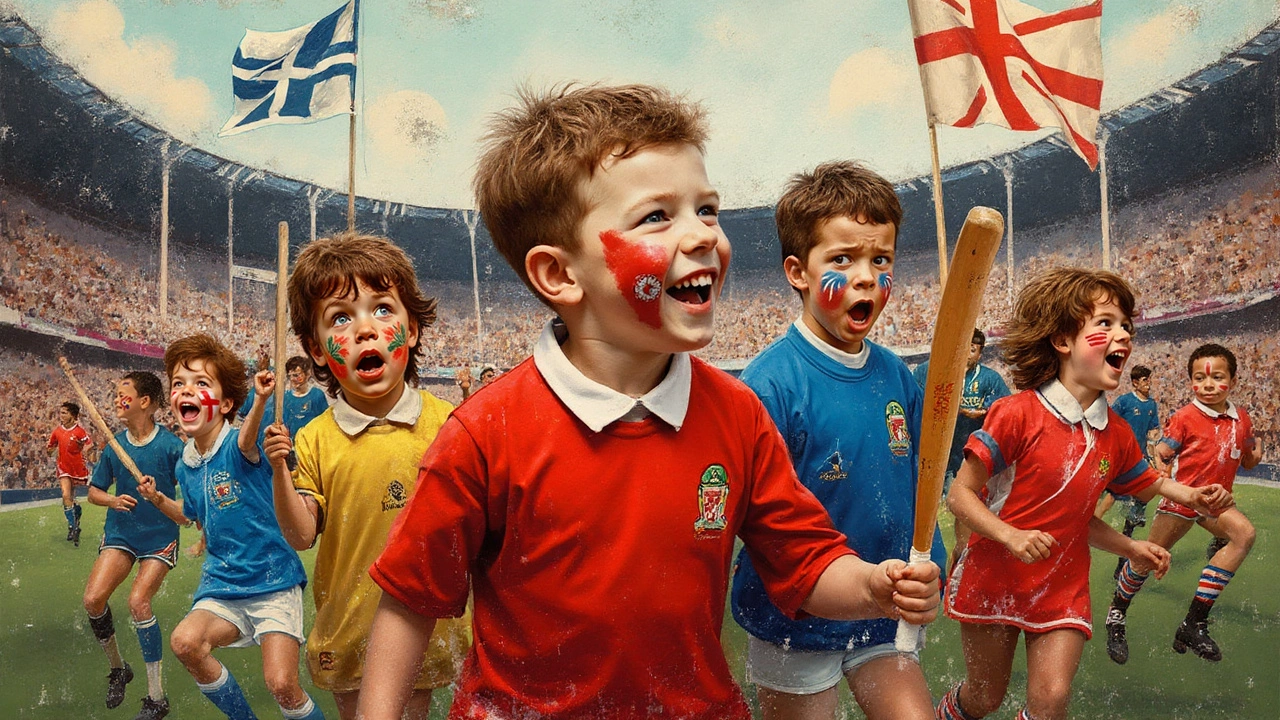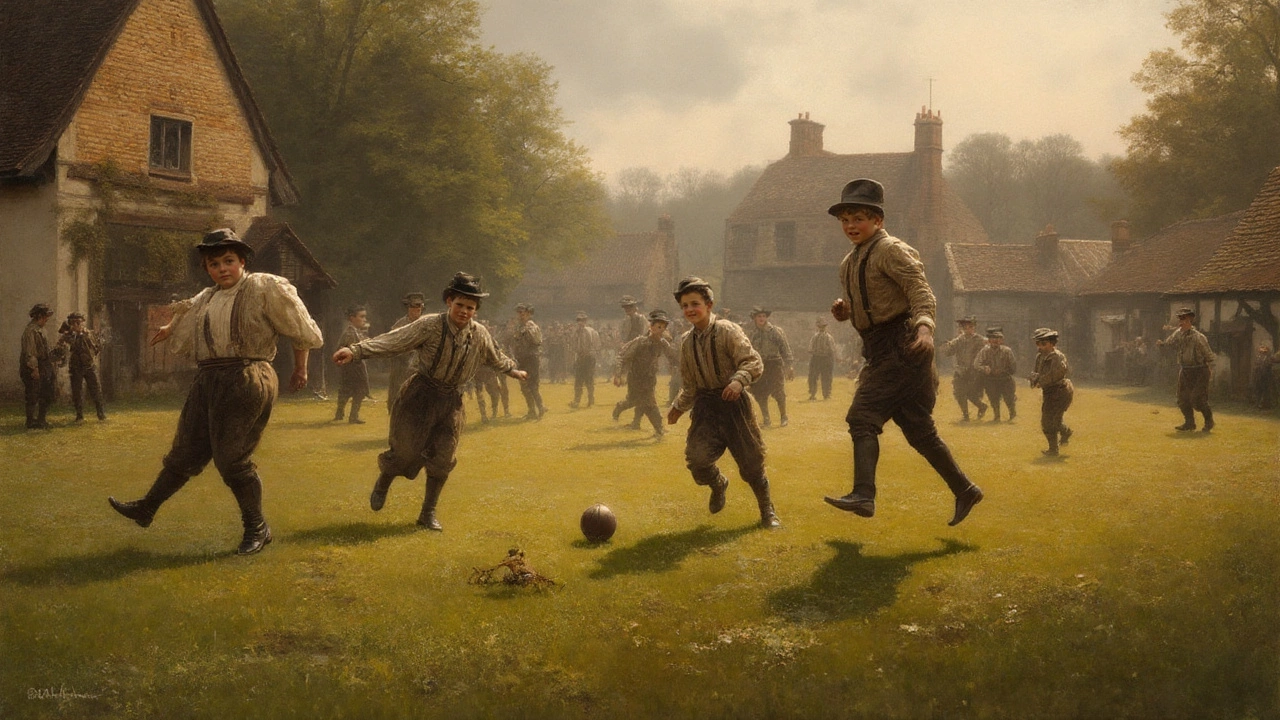Picture England in the early 1800s: muddy streets, cobbled town squares, and rowdy young lads chasing leather balls through chaos. Back then, everyone argued about football rules. Some thought you could run while carrying the ball. Others? Only the feet would do. Inside this thrilling tug-of-war, one big question has always split the crowd. What came first: English football or rugby?
The Chaotic Beginnings of Football and Rugby in England
Start with the dizzy mess that was football in England centuries ago. We’re not talking the tidy Premier League pitches or gleaming stadiums. Folks played football on main roads, in villages, between rival towns—even across churchyards. Anything went: kicking, tripping, punching, pushing, and sometimes hauling the ball into town with a mob behind you. Written accounts from the twelfth and thirteenth centuries show football’s been part of English life for longer than anyone can pin down.
Balls? Often pig bladders. Rules? Invented on the fly. Each village and public school developed its own wild take on how the game should work. In towns like Ashbourne, they still play the "Royal Shrovetide Football" match every year—its open-ended chaos is basically medieval football alive and kicking. Even today, the rules let hundreds of players barrel down streets and through rivers, echoing how it once was.
But football’s messy origins don’t mean rugby wasn’t there too. The two sports are like siblings fighting for the same toy: similar at first, but slowly pulling apart. At public schools like Eton, Harrow, and, most famously, Rugby School, the local version of football started adding a twist. Players weren’t just kicking the ball; some kids would pick it up and run, to the fury of those who saw it as cheating. By the early 1800s, the confusion had reached boiling point.
This great divide actually came to a head in 1823, at Rugby School. Here’s the legend: a boy called William Webb Ellis “with a fine disregard for the rules of football as played in his time, first took the ball in his arms and ran with it.” He basically invented rugby with a bit of rebellious cheek. The gap between “carry football” and “kicking football” widened quickly. By the 1840s, schools started writing down their rules. At Cambridge in 1848, students tried to hash out a compromise—should you use hands or feet? Even then, nobody could agree. It would take another 15 years before the story got clearer.
So, if you’re looking for a winner in the football vs rugby timeline, here's what you find: English football in one shape or another goes way back—think 1100s or earlier—with rugby splitting away in a formal sense in the 1800s. The earliest references to “football” rarely look like modern soccer, though; they describe a wild mix including what would become rugby too. It's less a neat A-then-B and more like a family tree with tangled branches.
| Year | Event | Sport | Location |
|---|---|---|---|
| 1170 | First reference to football in England | Football (general) | London |
| 1823 | William Webb Ellis reportedly runs with the ball | Rugby (origin legend) | Rugby School |
| 1848 | Cambridge Rules written | Football | Cambridge |
| 1863 | Football Association formed | Association Football (Soccer) | London |
| 1871 | Rugby Football Union formed | Rugby | England |

Rulebooks, Rivalries, and the Fight to Define Each Sport
By the mid-19th century, things started to sharpen up. You can thank the growing number of universities and schools, each tired of showing up and having to ask, “Wait, can we use our hands here or not?” If a school team from Rugby or Eton turned up at a local tournament, chances were the match would descend into heated shouting about which rules to follow.
This chaos couldn’t last. In 1863, a bunch of football clubs met at the Freemasons’ Tavern in London to thrash things out. They drew up the Laws of the Game for Association Football. These brand-new rules—you can’t use your hands, no hacking at shins, don’t carry the ball—became the backbone of modern soccer. The Football Association (FA) was born. Worth noting: a handful of clubs bailed out after these decisions. They weren’t happy about banning “carrying” and “hacking”, which they thought were part of football’s DNA. These clubs would fuel rugby’s growth.
The first official FA Cup in 1871 was a breakthrough. Now, players knew exactly what you could (and could not) do on the pitch. If you watch today, things like corners, throw-ins, and penalty kicks all stem from those original rules. The separation was clear—but the story didn’t end there.
On the rugby side, old traditions held on. Those clubs and schools that wanted the rough-and-tumble, fast-paced action of running with the ball founded the Rugby Football Union in 1871. Rugby wasn’t just one sport either; a few decades later, arguments about professionalism and payments led to another split between “Rugby Union” and “Rugby League.” That’s why you get two types of rugby today, each with its quirks.
Did you know that early rugby matches could field 20 players a side, while early football often saw even more on the pitch at once? Stuff like team size, pitch markings, and even the look of the ball kept evolving through the late 1800s. Classic rugby balls got their trademark oval shape in the 1870s—before that, they looked a lot like the rounder soccer balls we know today. The first soccer balls were made from inflated pig bladders covered in leather, laced up like a boot.
Want some fun trivia? For decades, English public schools played so rough that the government and church authorities tried to ban football and its close cousins. In 1314, King Edward II threatened Londoners with jail time for kicking balls in the street, worried it caused more riots than actual war. But the bans never stuck. People just loved chasing after a ball more than following royal rules.
There’s a twist when you look at how clubs and communities picked their sides. Some towns and cities went all-in on association football, while others stuck with rugby. If you go to Yorkshire today, rugby league is almost a religion. In the Midlands, union is king. London, Manchester, and Liverpool, though, breathe soccer—or football, as the English never stop calling it.
- Tip for fans: the split in rules means many classic football and rugby terms are linked. A "try" in rugby comes from the early rule where putting the ball down got you a “try” at goal, not the automatic points it brings now. "Offside" —in both games, though defined differently—was a headache from day one.
- If you love trivia, look up the 1872 match between Scotland and England, the world’s first official international football game. It happened just one year after the Rugby Union formed. Fans of both sports still debate which game draws bigger crowds, but both claim hundreds of millions of players and supporters worldwide.
The beef over rules, names, and which is “the real football” still makes pub debates lively across the UK. Even in Australia, New Zealand, and South Africa, folks argue about which came first. The answer? Depends how you define “first”—but it’s clear both football and rugby grew side-by-side, pulling in different directions as the decades rolled on.

The Cultural Impact: Football, Rugby, and the English Identity
Walk through any English city on a Saturday afternoon, and you’ll see just how far these two games have come. Premier League football fills stadiums and living rooms, and international rugby matches bring pubs to a standstill. Millions wear the shirts, chant the anthems, and know every stat about their teams. Football is so deeply woven into English identity it’s joked that, even if the national side always seems to crash out early, hope springs eternal every four years at the World Cup.
But rugby isn’t just a side act. Six Nations weekends mean pubs packed to the rafters with fans in shirts and scarves, roaring every try and tackle. Rugby’s reputation for respect, fierce rivalry, and sportsmanship makes it both a schoolboy staple and a professional powerhouse. If you’ve ever watched England lift the Rugby World Cup in 2003—or even just a classic muddy school match—you know how intense the love runs. Compared to football’s roots in villages and city streets, rugby has always felt a bit more linked to the country’s grand old schools but has since become a sport for everyone.
Beneath the fun and passion lies a core English value: loyalty. Fans stick with their club or school from cradle to grave. There’s a joke that you can change your job, your house, even your spouse—but never your football or rugby team. Since both sports grew out of the same rough-and-tumble seed, they share a DNA of community spirit, ritual, and just a hint of law-breaking mischief.
Interesting fact: the English Football Association is the oldest in the world, established in 1863. The Rugby Football Union isn’t far behind, from 1871. Between 1908 and 1948, both football (as soccer) and rugby union were Olympic sports—though rugby has now been replaced by rugby sevens in the Games. Both sports have shaped language, fashion, and even politics. Songs, chants, sense of humor—it all ties back to that old English urge to chase a ball and outwit the other side.
And there’s real money at stake today. As of 2024, the English Premier League pulled in worldwide TV rights worth over £10 billion, dwarfing most other sports leagues. The Rugby World Cup in 2019 drew over 857 million viewers. Whether you measure by players, watchers, or money, both games are now global superstars. Schools still use both to teach teamwork, leadership, and fair play.
If you’re on the fence about which sport to try, here’s the bottom line. Football waves the flag for simplicity: just a ball, a patch of grass, and an anything-goes attitude (at least, until the referee blows the whistle). Rugby, meanwhile, rewards grit, tactical thinking, and a love of the big hit—plus you’ve got to keep your wits about you for the offside trap and the rolling maul. Wherever you start, you’re playing a slice of English tradition.
So, what’s the takeaway? History of football in England stretches back further, tangled into centuries of chaos, bans, and breakneck matches. Rugby emerged out of that twist, carving its own fierce path in the 1800s. They’re brothers, not rivals—and wherever you line up on the green, you’re part of one big, messy, stubbornly proud English legacy.
